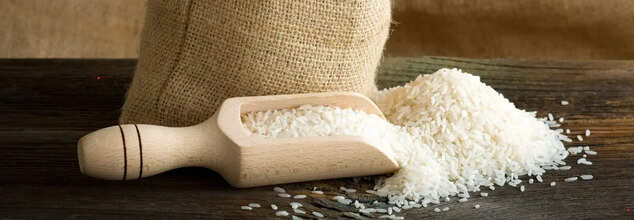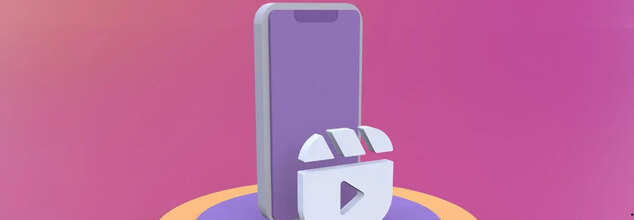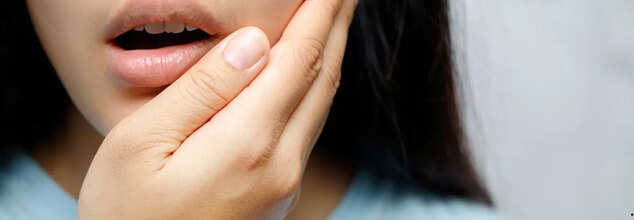
Credit: Canva
How To Use Rice Water To Grow Your Hair?
Rice water has been a staple in beauty rituals for centuries, particularly in Southeast Asia. As per historical records, women in China and Japan have been washing their hair with rice water due to its hydrating and nourishing properties, benefiting both the scalp and hair, as well as brightening and soothing the skin. For the uninitiated, rice water is simply water that has been fermented with rice, and it can be easily made at home or found in various hair-care products. But does it actually live up to its claims?
Health Benefits Of Rice Water
One of the primary reasons people turn to rice water is because of its nutrient value and potential to expedite hair growth. Viral TikTok videos often showcase dramatic before-and-after transformations, where users report significant increases in hair volume and length in just a few weeks of using it. However, experts urge caution, as most of these hair growth claims are anecdotal. They argue that while it has nourishing properties, more research is needed to substantiate its hair growth claim.
Regardless, there is no denying the fact that rice water contains beneficial vitamins and minerals that can support a healthy scalp and hair function. Hill explains that rice water's amino acids, B vitamins, vitamin E, and antioxidants can strengthen hair strands. It also acts as a protein treatment that helps minimize frizz and smoothens the hair, making it more manageable.
How to Use Rice Water for Hair?
Incorporating rice water into your hair care routine is easy. You can start by pouring rice water over your hair after shampooing and conditioning, allowing it to soak in for maximum benefit. Alternatively, you can use a spray bottle to apply it on your scalp immediately after washing your hair. If you're using any other product with rice water, be sure to follow the instructions provided on the packaging for optimal results.
Interestingly, you can make rice water at home. You can make it by soaking half a cup of uncooked rice in two cups of water for about an hour. After this, you need to strain the rice and save the liquid in a container, such as a spray bottle.
Potential Side Effects
While rice water is generally safe for most people, it may not suit every hair type. Hill warns that individuals with high-porosity hair (hair that easily absorbs water and products) are more likely to benefit from rice water than those with low-porosity hair. For those with low-porosity hair, using rice water could lead to protein buildup, which might weigh down the hair or cause it to become brittle. It's important to understand your hair type before using rice water.Additionally, combining food-based products like rice water with over-the-counter or medicated treatments may cause adverse reactions due to incompatible ingredients. If you have scalp conditions such as dandruff or eczema, it's crucial to consult with a dermatologist or trichologist before using rice water or any other food-based treatment. If you're seeking significant hair growth, experts recommend using proven ingredients like minoxidil in conjunction with rice water, rather than as a replacement.

Credit: Canva
Reel-Induced Eye Damage Is Real—Here's What To Do
After growing concerns about the effects of short-form videos on mental health, doctors are now warning of a new and escalating crisis—‘reel-induced eye damage.’ Excessive screen time, particularly binge-watching reels on social media platforms such as Instagram, TikTok, Facebook, and YouTube, is leading to a surge in eye disorders across all age groups, with children and young adults being the most affected.
This issue was highlighted by leading ophthalmologists during the ongoing Joint Meeting of the Asia Pacific Academy of Ophthalmology and All India Ophthalmological Society at the Yashobhoomi-India International Convention and Expo Centre on Tuesday.
Asia Pacific Academy of Ophthalmology (APAO) 2025 Congress president Dr Lalit Verma raised serious concerns about the ‘silent epidemic of digital eye strain’ triggered by excessive screen exposure. “We are witnessing a sharp rise in cases of dry eye syndrome, myopia progression, eye strain, and even early-onset squinting, especially in children who spend hours watching reels,” he stated.
“A student recently visited us with complaints of persistent eye irritation and blurry vision. Upon examination, we found that his eyes were not producing enough tears due to prolonged screen time at home watching reels. He was immediately prescribed eye drops and advised to follow the 20-20-20 rule—taking a 20-second break every 20 minutes to look at something 20 feet away,” Dr Verma added.
Reels Capture Your Attention For A Lot Of Time
Dr Harbansh Lal, chairman of the Organising Committee and president of the All India Ophthalmological Society, elaborated on the severity of the issue. He explained that short, engaging reels are designed to capture and retain attention for extended periods.“However, constant screen fixation reduces blink rates by 50%, leading to dry eye syndrome and accommodation spasms, which make it difficult to shift focus between near and distant objects. Experts warn that if this habit remains unchecked, it could lead to long-term vision problems and even permanent eye strain,” he cautioned.
Dr Lal further emphasized that children who spend hours daily glued to reels are at an increased risk of developing early-onset myopia, which is progressing faster than ever before. Adults, too, are experiencing frequent headaches, migraines, and sleep disorders caused by blue light.
Recent studies indicate that by 2050, over 50% of the world’s population will be myopic, making it the leading cause of irreversible blindness. The increasing screen time has also led to fluctuating lens prescriptions until the age of 30, a shift from the previous norm of 21, Dr. Lal noted.
Research shows a growing number of people, particularly students and working professionals, are struggling with digital eye strain, squinting, and worsening eyesight due to prolonged exposure to high-speed, visually stimulating content. Doctors are also observing a concerning trend of social isolation, mental fatigue, and cognitive overload linked to constant reel consumption.
Dr Samar Basak, president of AIOS and a senior ophthalmologist, highlighted the social and psychological toll of excessive screen time. “We are noticing a pattern where people become so engrossed in reels that they neglect real-world interactions, leading to strained family relationships and a decline in focus on education and work.”
Dr Partha Biswas, senior ophthalmologist and incoming president of AIOS, warned, “The combination of artificial lighting, rapid visual changes, and prolonged near-focus activity overstimulates the eyes, leading to a condition we call ‘Reel Vision Syndrome.’ It’s crucial to address this before it escalates into a full-scale public health crisis.”
To mitigate the harmful effects of excessive reel-watching, ophthalmologists recommend adopting the 20-20-20 rule, increasing blink rates, consciously making an effort to blink more frequently while using screens, reducing screen time, and taking digital detoxes through regular breaks.
With eye disorders on the rise due to unregulated reel consumption, health experts urge parents, educators, and social media users to take immediate preventive measures. “Reels may be short, but their impact on eye health can last a lifetime,” warned Dr. Lal.

When To Take A Break From IVF Treatment After Failed Cycles?
Starting on journey of in vitro fertilization (IVF) is a very personal and emotional process. For most couples, it is a hope—a chance to maybe finally be able to achieve their dream of having a family. But what isn't discussed nearly enough is exactly how physically, emotionally, and financially draining this process can be.
Between countless doctor visits, daily hormone injections, unpredictable outcomes, and the immense pressure to succeed, IVF can start to take a serious toll. It’s not just about the body; it affects the mind, relationships, and overall well-being. This is why taking a break—stepping back to breathe and reset—can be an essential part of the process.
But how will you know when it's time to stop? And perhaps more important, how do you handle the emotional burden of deciding? If you find yourself drained, overwhelmed, or wondering if you should continue, know you are not alone. Here's what you need to know about IVF burnout, why it occurs, and how stopping might actually advance you.
For most couples, having children is a dream come true. When natural conception is no longer possible, in vitro fertilization (IVF) is usually the light at the end of the tunnel. Although the progress in fertility treatments has enabled many couples to conceive, the process is not an easy one. IVF is a time-consuming, costly, and emotionally draining process that demands an unrelenting commitment. The endless cycle of doctor visits, hormone shots, procedures, and waiting can be draining on both partners.
Although promising, IVF is not an assured route to success. Failed cycles, cycles of repeated disappointments, and uncertainty about the process can result in severe emotional distress. Most couples feel feelings of shame, guilt, frustration, and anxiety, so it is vital to know when a break is necessary.
What is IVF Burnout and Why Does It Happen?
Dr. Vandana Ramanathan, Fertility Consultant at GarbhaGudi IVF Centre, describes IVF burnout as a condition of mental and physical fatigue resulting from extended treatment. "This fatigue can be caused by repeated failed cycles, long procedures, and uncertainty of results," she adds.
Unlike most other medical treatments, IVF has a strong emotional component. Each cycle costs the couple considerable amounts of financial, physical, and emotional capital, often creating unbearable pressure on their part. Not only is there medical stress involved, but social pressures and a lack of support also add to the experience and lead to burnout.
Recognizing the Signs of IVF Burnout
Burnout also appears in different ways to every person, based on their stress-coping mechanisms. The symptoms can be divided into mental and physical symptoms:
Mental Signs:
- Enduring depression and anxiety
- Irregular mood swings and heightened irritability
- Lack of motivation and interest in daily tasks
- Social isolation and withdrawal
Physical Signs:
- Chronic fatigue and exhaustion
- Sleep disturbances, including insomnia
- Gastrointestinal disturbances and changes in appetite
- Headaches and body aches occurring frequently
- Panic attacks and palpitations
- Hypertension and blood sugar fluctuations caused by stress
When Do You Need to Take a Break?
It's always hard to admit that you need a break when you've invested so much in the journey. But taking a step back doesn't translate to quitting—it's about taking care of yourself as a whole. Dr. Ramanathan says that taking a break doesn't lower the success rate of IVF procedures. Moreover, it can be helpful. If the patient is not ready physically or psychologically for the next cycle, chances for success may be affected as well. We usually suggest taking a break for several months before resuming," she elaborates.
Some couples realize this on their own, seeing that the process is exhausting them. Others might require their doctor to advise them. Either case, a break can last anywhere from a month to six months, depending on the couple's state of mind. The objective is to restore emotional balance and make sure that both partners are mentally ready for the next step in treatment.
How to Manage IVF Burnout and Gain Emotional Balance?
Prioritizing Self-Care
Self-care is one of the most important things about breaking the cycle of IVF burnout. Stress can be controlled by practicing yoga, meditation, and breathing exercises. "The patients need to engage in relaxation activities that allow them to feel in control of their emotions," states Dr. Ramanathan.
Having a Balanced Diet
IVF processes use high doses of medication, and therefore adequate nutrition is key. A well-balanced diet full of vitamins, minerals, and hydration benefits the body throughout the process and also aids in stress management.
Adequate Sleep
Sleep tends to be interfered with because of stress, but sleep is crucial to well-being. A minimum of six to eight hours of rest will help the body heal.
Adding Exercise
Physical activity can serve as an excellent stress reliever. Whether it’s walking, yoga, or any preferred form of exercise, staying active for at least an hour a day can help balance hormones and improve mental health.
Open Communication
IVF is not only a physical procedure—it's emotional too. Couples must be open with one another and their physician. Talking about fears, challenges, and expectations can ease emotional burdens. "If couples feel they cannot manage the stress themselves, professional counseling can be very helpful," says Dr. Ramanathan.
Setting Realistic Expectations
Knowing that IVF is a hard process with setbacks is the bottom line. Different people react in different ways to treatment, and outcomes can differ. Acknowledge these unknowns and be realistic about expectations in order not to burn out.
Why Taking a Break is Not Giving Up?
Time off from IVF is not failure. Rather, it is a chance to rest, recharge, and come back to the process with renewed vigor. "Patients who take a break often return feeling more optimistic and emotionally prepared," Dr. Ramanathan reports.
If you find it too much, taking a break for a while can be the best option for your physical and mental health. When things are ready, you can go back to the process with a new mind and a better attitude.

Credit: Canva
These 4 Signs Can Help You Identify Cavities-And What You Should Do
Cavities are one of the most common dental issues, yet they often go unnoticed until the problem worsens. I, myself, have faced this!
Cavities, commonly referred to as tooth decays, are caused by bacteria in plaque using sugars and starches. The bacteria in your mouth form a sticky film that causes plaque in teeth. Every time you eat or drink anything with sugar or starch, this bacteria in plaque breaks them down, producing acids. These acids eventually lead to enamel erosion. Over time, the enamel weakens and breaks down, forming a cavity or a hole in the tooth.
Recently, dentist and social media influencer Dr Lavina Kumar, highlighted four key signs that could indicate the presence of a cavity—and why you shouldn’t ignore them.
In the video, she explained that tooth sensitivity, especially when consuming cold drinks, could be an early warning sign. Persistent toothache, food frequently getting stuck between teeth, and the sensation of a hole in your tooth are also strong indicators that a cavity may be developing.
The NHS also warns that tooth decay can manifest as sharp pain when eating or drinking hot, cold, or sweet foods. Visible white, brown, or black spots on the tooth may also signal decay.
However, treatment is possible. Based on the severity, you dentist can offer you different options. Early-stage cavities can sometimes be reversed with fluoride treatments such as mouthwash or varnish. However, if decay progresses, a filling may be required. In severe cases, a root canal or even tooth extraction may be the only remaining solution.
Tooth Decay: Do’s and Don’ts
To avoid tooth decay and maintain strong teeth, consider the following tips:Do’s
- Brush Before Breakfast: UK dental surgeon Shaadi Manouchehri advises brushing before eating breakfast to remove the bacteria that builds up overnight. This practice shields your teeth from acidic food and drinks that can weaken enamel.
- Choose Healthy Snacks: Opt for raw vegetables, nuts, or fruits that are low in sugar and require chewing, which stimulates saliva production and naturally cleans the teeth.
- Use Xylitol Gum: Chewing gum with xylitol after meals can boost saliva flow and reduce the risk of cavities.
- Wait Before Brushing After Meals: If you prefer to brush after eating, wait at least 30 minutes to allow your enamel to re-mineralize and harden.
Don’ts
- Avoid Sugary Snacks: Fermentable carbohydrates, such as chips, crackers, and cereal, turn into sugars that fuel the growth of harmful bacteria in the mouth.
- Skip Brushing After Acidic Meals: Acidic foods and drinks can weaken your enamel. Brushing immediately after consumption can wear away the softened enamel, leading to cavities.
- Don’t Skip Hydration: Drink water after meals to help neutralize acids and wash away remaining food particles in your teeth.
Maintaining optimal dental health takes more than just brushing and flossing twice a day. Adding such healthy eating habits, timing your brushing routine, and using xylitol gum after meals, you can protect your teeth from decay and promote stronger enamel.
© 2024 Bennett, Coleman & Company Limited

